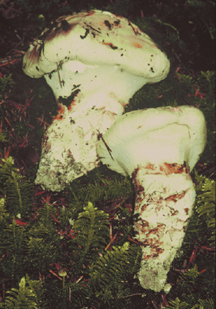

SilviShrooms
Predicting edible mushroom productivity using forest carbon allocation modeling and immunoassays of ectomycorrhizae




Alexander, S. J., Pilz, D., Weber, N. S., Brown, E. and Rockwell, V. [Submitted] Value estimates of commercial mushrooms and timber in the Pacific Northwest. Environmental Management.
Bergius, N., and Danell, E. 2000. The Swedish matsutake
(Tricholoma nauseosum syn. T. matsutake): distribution,
abundance, and ecology. Scandinavian Journal of Forest Research
15: 318-325.
Coops, N. C., Waring, R. H., and Landsberg, J. J. 1998. Assessing
forest productivity in Australia and New Zealand using a physiologically-based
model driven with averaged monthly weather data and satellite
derived estimates of canopy photosynthetic capacity. Forest Ecology
and Management 104: 113-127.
Danell, E. 1994. Formation and growth of the ectomycorrhiza of
Cantharellus cibarius. Mycorrhiza. 5: 89-97.
Danell, E. 1999. Cantharellus. Chapter 10. In: Cairney, J. W.
G. and Chambers, S. M. eds. Ectomycorrhizal fungi: key genera
in profile. Springer-Verlag. Berlin.
Egli, S., Ayer, F., Chatelain, F. 1990. Der Einfluss des Pilzsammelns
auf die Pilzflora. Mycologia Helvetica 3: 417-428.
Hall, I., Buchanan, P. K., Yun, W., and Cole, A. L. J. 1998. Edible
and poisonous mushrooms: an introduction. New Zealand Institute
for Crop & Food Research Limited. Christchurch, NZ.
Landsberg, J. J. and Waring, R. H. 1997. A generalized model of
forest productivity using simplified concepts of radiation use
efficiency, carbon balance and partitioning. Forest Ecology and
Management 95: 209-228.
Miller, S. A., Rittenburg, J. H., Peterson, F. P. and Grothaus,
G. D. 1988. Application of rapid, field usable immunoassays for
the diagnosis and monitoring of fungal pathogens in plants. pp.
795-803. In: Brighton Crop Protection Conference, Pests and Diseases.
Surrey: British Crop Protection Council.
Norvell, L. 1995. Loving the chanterelle to death? The ten-year
Oregon chanterelle project. McIlvainea 12: 6-25.
Neuner-Plattner, I., Grabher, T., Hall, I. R., Stöffler,
G., Griffin, F. and Haselwanter, K. 1999. A comparison of immunological
assays for the identification of Tuber spp. and other edible
EM fungi. Mycological Research 103(4): 403-412.
Pilz, D., Molina, R., 1998. A proposal for regional monitoring
of edible forest mushrooms. Mushroom, The Journal of Wild Mushrooming.
16(3): 19-23.
Pilz, D., Brodie, F. D., Alexander, S., and Molina, R. 1998. Relative
value of chanterelles and timber as commercial forest products.
pp. 14-15. In: Liegel, L. H. (compiler). The biological, socioeconomic,
and managerial aspects of chanterelle mushroom harvesting: The
Olympic Peninsula, Washington State, U.S.A. Ambio, A Journal of
the Human Environment. Special Report Number 9, September, 1998.
Stockholm, Sweden: Royal Swedish Academy of Sciences.
Pilz, D., Smith, J., Amaranthus, M. P., Alexander, S., Molina,
R. and Luoma, D. 1999. Mushrooms and timber: managing commercial
harvesting in the Oregon Cascades. Journal of Forestry 97(3):
4-11.
Yajima, I., Yanai, T., Nakamura, M., Sakakibara, H. and Hayashi, K. 1981. Volatile flavor compounds of matsutake - Tricholoma matsutake (Ito et Imai) Sing. Agricultural and Biological Chemistry 45(2): 373-377.
Trappe, J. M. 1996. What is a mycorrhiza? pp. 3-6. In: Azcon-Aguilar, C. and Barea, J. M. Mycorrhizas in integrated systems from genes to plant development. Proceedings of the fourth European Symposium on Mycorrhizas. Granada, Spain. July 11-14, 1994. Published by the European Commission; Directorate -General XII; Science, Research, and Development; B-1049 Brussels. Printed in Italy by: Office for Official Publications of the European Communities, Luxembourg.